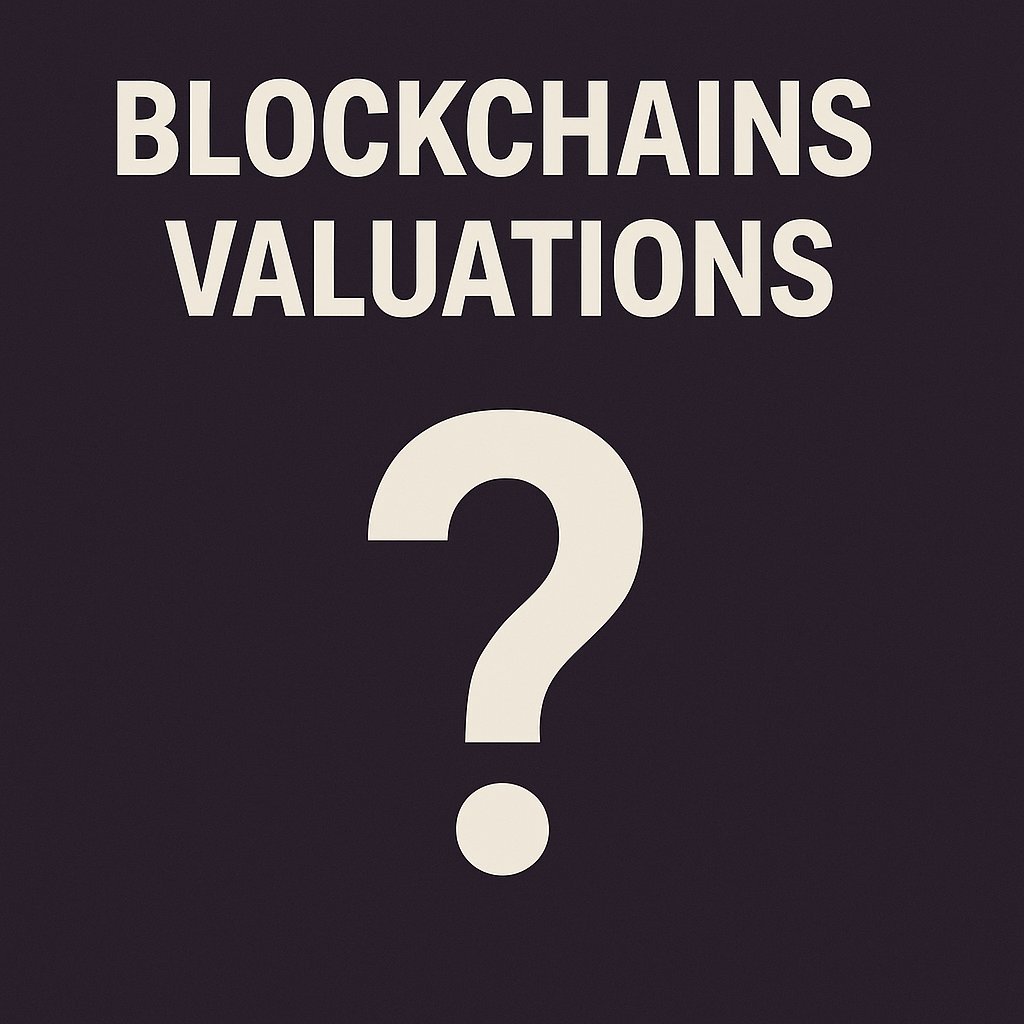Rethinking Blockchain Valuation for the Age of Decentralized Infrastructure
Traditional metrics fail to capture what blockchains really are. A new paradigm is needed—one rooted in usage, monetary flows, public utility, and economic footprint.
Valuing blockchains today is like trying to price the internet before we understood what websites were. In the early days of the web, analysts applied familiar but flawed frameworks, eyeballs, banner ad revenue, burn rates, only to discover later that none of these captured what truly drove value. We are in a similar moment with blockchains: despite their economic and social significance, there is no widely accepted or standardized model for how they should be valued.
This lack of consensus isn’t due to a shortage of effort. Several frameworks have been proposed, each bringing something to the table, yet each falling short in key ways. It’s time to step back and recognize both the limitations of these existing models and the need for something more native to how blockchain economies function.
The DCF and Fee-Based Model: Misapplied Logic
The most common approach, particularly among traditional financial analysts, has been to apply Discounted Cash Flow (DCF) models or focus on fees generated by the protocol or its validators. This method treats a blockchain like a software-as-a-service (SaaS) company, estimating its future cash flows and discounting them back to present value.
But this framework quickly collapses under scrutiny:
Blockchains aren’t companies. They don’t have shareholders, retained earnings, or management seeking to maximize profits.
Fee structures are dynamic and often political. Protocols can—and do—lower fees for strategic reasons (e.g., Layer 2 scaling).
Subsidies distort reality. Some ecosystems, such as Solana, heavily subsidize validator revenues, which inflates perceived “earnings” without reflecting real, organic usage.
Ultimately, DCF assumes a central issuer and a predictable revenue stream, neither of which are natural to decentralized public blockchains.
MSOV: The Monetary Store of Value Model
Another model gaining traction is the Monetary Store of Value (MSOV) framework, which values a blockchain asset based on how it is used within financial primitives—primarily staking and deposits in on-chain finance. The underlying idea is that an infrastructure token can be understood like a commodity used for economic functions, rather than a security or equity instrument.
The MSOV model captures useful elements, especially for “economic base-layer” assets like ETH. However, it has its own limitations:
It largely ignores the flow dimension—how capital moves through the ecosystem.
It overweights capital sitting idle (e.g., locked/staked ETH) rather than capital actively in use.
It may fail to capture emerging use cases like Layer 2 payments, NFTs, and real-world asset tokenization.
MSOV is a helpful lens for one facet of valuation—especially for understanding “capital at rest”—but it does not account for the vibrancy or velocity of network activity.
On-chain GDP: Thinking Like Economists
Another promising category is on-chain GDP models. These attempt to measure the total economic output facilitated by a blockchain network, borrowing from macroeconomic concepts like gross domestic product. Onchain GDP models typically consider:
* Fees paid for computation and storage
* Total value locked (TVL)
* Stablecoin issuance and circulation
* Application revenue (on DeFi, NFTs, etc.)
* Layer 2 and off-chain asset interactions
Importantly, this model is often split into two components:
Chain GDP – Activity directly on the base chain (e.g., Ethereum L1)
App GDP – Economic activity on top of that chain (e.g., L2 apps, stablecoin usage, DeFi protocols)
Onchain GDP is a major step in the right direction, but its limitations are structural:
It’s hard to normalize across chains. Not all blockchains publish comparable data, and GDP definitions vary.
It lacks granularity. Many “GDP” metrics conflate internal operations (e.g., staking rewards) with actual user-facing value.
It still doesn’t track economic velocity. You can measure the size of an economy, but not its pulse.
As a sidenote, the data layer aspect of blockchains is still missing from valuation frameworks.
A New Lens: Valuing Blockchains by Velocity and Flow
Recognizing these gaps, I’m developing an emerging framework centered on monetary velocity and value flow within the blockchain economy. This approach is built on the premise that blockchains are best understood as dynamic economic systems, not static financial entities.
In this model, what matters most is not just how much value a chain holds, but how that value moves:
How quickly do stablecoins circulate?
How often are NFTs traded?
How frequently are tokens bridged or swapped?
What is the use rate of assets in DeFi protocols?
What’s the flow of ETH across L1s, L2s, and dApps?
What are the tokenization volumes in real-world assets?
These questions underpin the “ETH in Motion” model I introduced. It’s a framework that blends economic theory with on-chain data to derive velocity-adjusted economic value, a proxy for how active, trusted, and productive a blockchain’s economy truly is.
Velocity-based valuation offers several advantages:
Harder to game: Unlike revenues or TVL, which can be inflated through incentives or wash trading, real economic velocity requires genuine demand.
Native to the technology: Flow and velocity align with the open, programmable nature of blockchain-based finance.
Captures the entire stack: Whether value flows across apps, chains, or bridges, this model accounts for composability in a multi-chain world.
Why This Matters
The absence of an accepted valuation standard is more than an academic problem. It:
* Confuses investors and allocators trying to differentiate between blockchains
* Enables manipulative marketing (e.g., inflating “revenues” to simulate traction)
* Hinders the development of credible, data-driven benchmarks for institutional adoption
It’s also worth recognizing that we may not find a single valuation model. Just as different equity analysts use EV/EBITDA, P/E, and discounted cash flows depending on the business model, blockchain valuation may require a multidimensional approach—one that blends MSOV, GDP, velocity, and more.
Toward a Valuation Framework That Matches the Innovation
Blockchain technology is too innovative, too fluid, and too transformative to be pigeonholed into 20th-century financial models. Public blockchains aren’t corporations; they’re networks, platforms, economies, and monetary systems all rolled into one. That complexity demands new thinking.
We don’t yet have a widely accepted model. DCF is insufficient. MSOV is useful but partial. GDP gives us scope, but not rhythm. Velocity and flow models may offer the missing ingredient: a way to measure how a blockchain lives.
The valuation frameworks of the future will be built, not inherited. And just as early internet investors had to invent new tools to understand what they were seeing, the blockchain world must now do the same.
If we get this right, we won’t just value blockchains more accurately. We’ll finally be able to understand what they’re really worth to the world.
via @ethereum_mrc

4
11.89K
The content on this page is provided by third parties. Unless otherwise stated, OKX is not the author of the cited article(s) and does not claim any copyright in the materials. The content is provided for informational purposes only and does not represent the views of OKX. It is not intended to be an endorsement of any kind and should not be considered investment advice or a solicitation to buy or sell digital assets. To the extent generative AI is utilized to provide summaries or other information, such AI generated content may be inaccurate or inconsistent. Please read the linked article for more details and information. OKX is not responsible for content hosted on third party sites. Digital asset holdings, including stablecoins and NFTs, involve a high degree of risk and can fluctuate greatly. You should carefully consider whether trading or holding digital assets is suitable for you in light of your financial condition.

